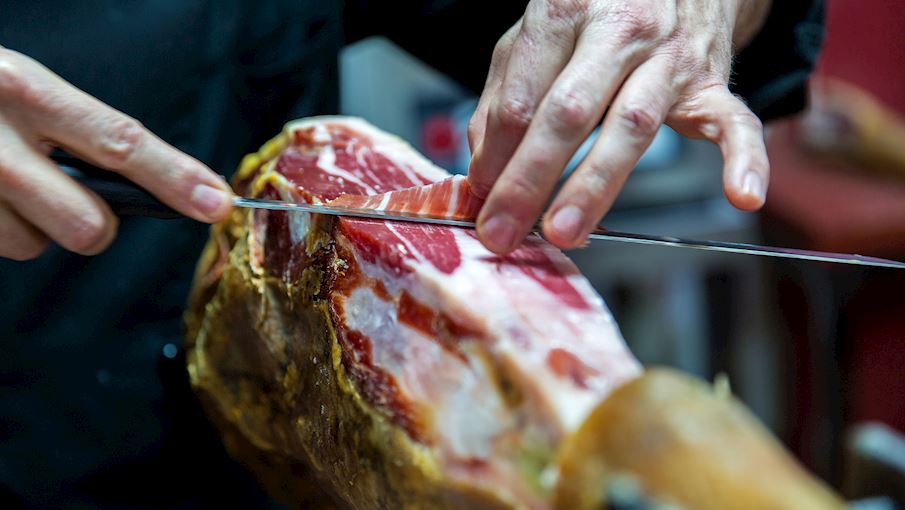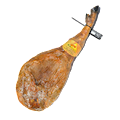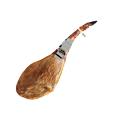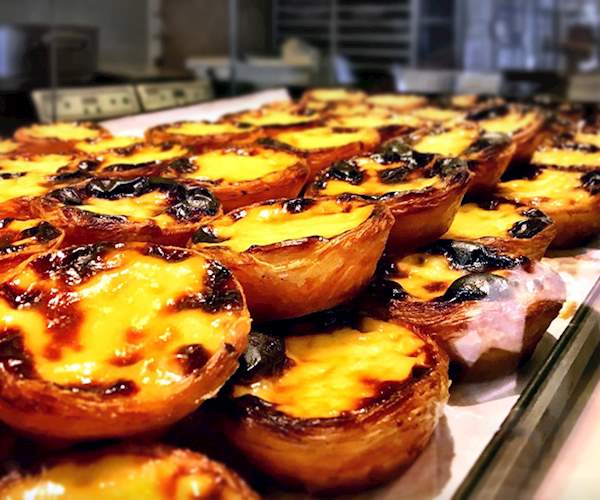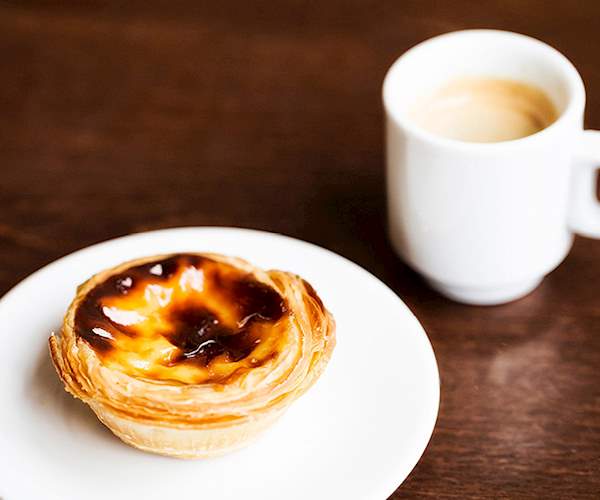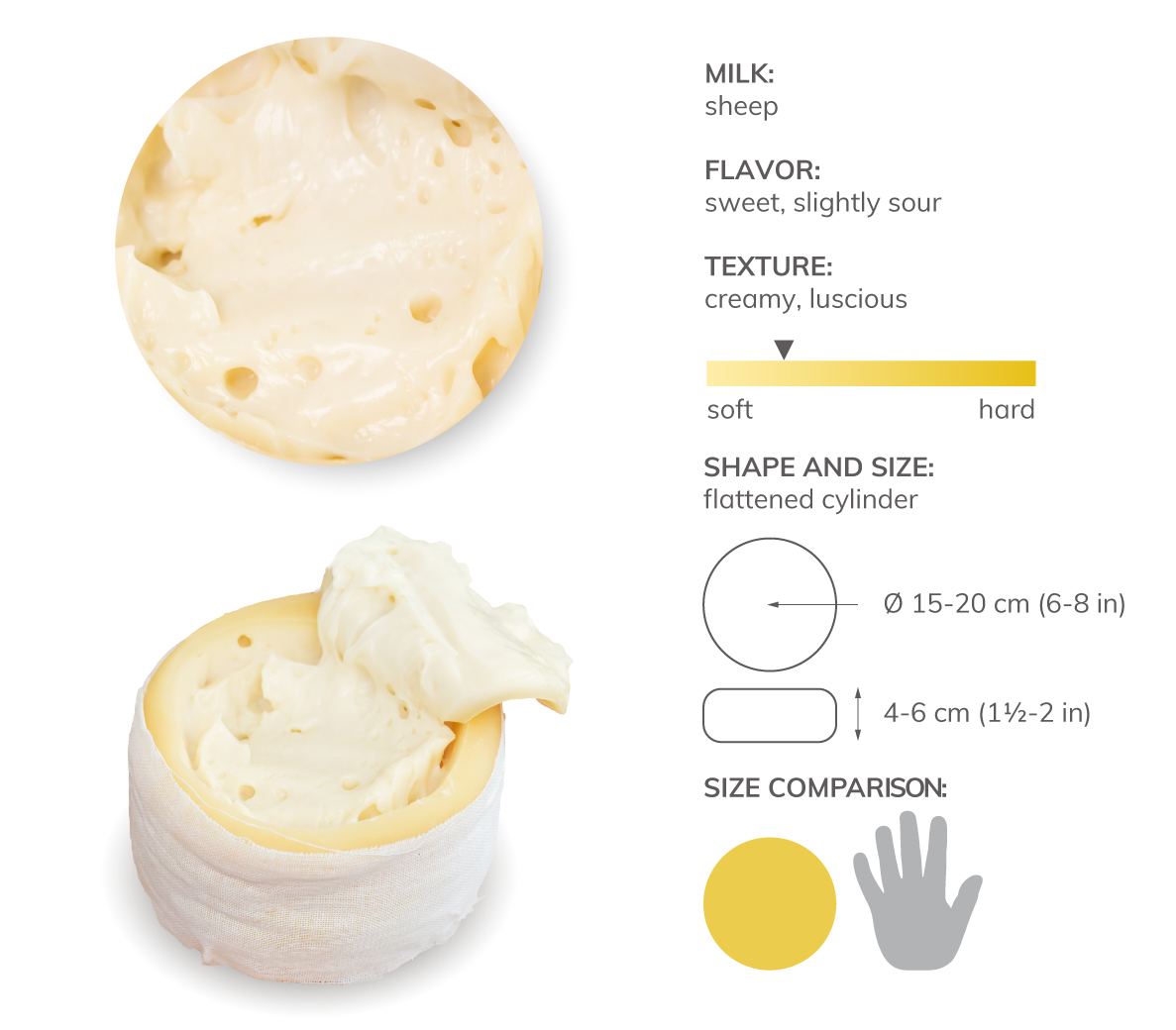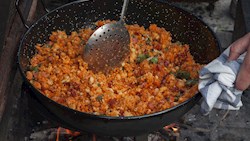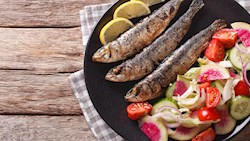This variety of Iberian ham is produced with meat coming from acorn-fed Iberian pigs that are either 75% or 50% pure Iberian breed, meaning they have been crossbred with other pigs such as the Duroc breed. As in the case of jamón 100% ibérico de bellota, the pigs used in the production of this ham are allowed to roam freely across the oak pasturelands in their final rearing stage, known as the montanera, eating an acorn-based diet until they reach the desired weight for the sacrifice, or the matanza as the Spanish call it. Jamón ibérico de bellota makes for about 13% of the total Iberian ham production and is distinguished by a red label.
The designated areas of Iberian bellota ham production include the Dehesa de Extremadura, Salamanca, Huelva, and Valle de Los Pedroches in Spain, along with Barrancos in Portugal.
OTHER VARIATIONS OF Jamón Ibérico
Pastel de nata is a traditional Portuguese egg custard tart that is popular throughout the world. It is believed that for the best result, the filling should not be too sweet and should not have flavors of lemon nor vanilla. Instead, the tarts should be sprinkled with cinnamon and, ideally, paired with a cup of coffee.
Originally, this treat was made before the 18th century by Catholic monks and nuns in Santa Maria de Belém in Lisbon. The tart was made from leftover egg yolks that were used in the clearing of wines and starching of clothes. Later on, the clerics made a deal with a nearby bakery to start selling pastel de nata commercially, and the product was a huge success.
MOST ICONIC Pastel de nata
View morePastel de Belém is a traditional Portuguese egg custard tart and a predecessor to the famous pastel de nata. The tarts are made with a pastry shell that's filled with a combination of milk, eggs, sugar, lemon, and cinnamon. The first recipe for pastel de Belém dates back to 1837 when it was produced by the monks of the Jerónimos monastery.
Only the custard tarts produced at the Fábrica Pastéis de Belém can be called pastel de Belém, while all the others, produced by other patisseries in Lisbon are called pastel de nata. Regardless of the name, these tarts can be served hot or cold and in 2009, The Guardian listed pastel de Belém as one of the 50 'best things to eat' in the world.
Serra da Estrela is a semi-soft cheese made from the milk of Bordaleira Serra da Estrela and Churra Mondegueira breeds of sheep. Milking is done by hand, after which the milk is heated, salted, and curdled using thistle extract.
The curd is formed into cheeses, which are left to ripen in humid and cold conditions. The cheese has a creamy, semi-soft interior that is yellowish-white in color, while its flavor is clean, sweet, and slightly sour. This cheese is Portugal's oldest, most traditional food product with international acclaim.
Pair with
This traditional Portugal dish combines marinated pieces of pork with clams and a lightly spicy, wine-infused sauce. Though the name of this classic might imply it originated in Alentejo, it is believed that it initially appeared in the Algarve region, but was given its current name because of the highly-prized black pigs that are most commonly reared in Alentejo.
The dish is a restaurant staple that is found throughout Portugal. It is usually garnished with fresh cilantro and paired with lemon wedges, pan-fried potatoes, and country-style bread on the side.
MOST ICONIC Carne de porco à Alentejana
View moreMAIN INGREDIENTS
Named after the 19th-century poet Raimundo António de Bulhão Pato, this simple Portuguese dish combines clams and a flavorful sauce that is based on olive oil, garlic, lemon juice, and fresh cilantro. However, the sauce can also have white wine as one of its ingredients.
Bulhão Pato clams are typically enjoyed as an appetizer and are usually served with bread on the side.
MOST ICONIC Amêijoas à Bulhão Pato
View moreAlentejo ham is a regional specialty made from the legs and shoulders of Alentejo pigs produced in the districts of Castelo Branco, Portalegre, Santarém, Évora, Beja, Setubal, and Faro. These areas typically have hot and dry summers and cold winters.
Throughout the centuries, the residents of these regions learned to work with this climate to develop a natural drying process for ham that does not resort to the use of smoke or any other external factors besides the addition of salt. When cut, the ham is reddish-pink to dark red and highly marbled.
The Campo Maior and Elvas ham and paleta are made using pork taken from Alentejo breed pigs raised in the municipalities of Campo Maior and Elvas in Portalegre. These pigs are raised outdoors, feeding on grasses, cereals, and legumes.
The ham is made from the hind leg of the pig, while the paleta is made from the foreleg. In both cases, the hoof and the outer skin is left on. The production process is based on local methods, and is divided into several stages: cutting, salting, the post-brining (drying), and curing or aging, which lasts up to a year under natural conditions.
MAIN INGREDIENTS
Espetada is a traditional Portuguese dish and a specialty of the island of Madeira. It consists of big pieces of beef that are marinated in salt and garlic, then skewered on a bay leaf stick. The stick is placed over hot coals until the meat is properly cooked.
It is the most popular dish to serve at picnics or parties in Madeira. Espetada is often served with the skewer hung vertically from a hook, so that the flavorful juices can drip down onto a plate filled with thick-sliced, crusty bread. Pork, sausages, and squid can all act as a substitute for beef in espetada, but then it is not a typical Madeira dish anymore.
MOST ICONIC Espetada
View moreFrango assado com piri piri, which is often simply referred to as frango assado (roasted chicken), is a Portuguese dish with vague origins. It is usually made with a whole butterflied chicken that can be marinated in a combination of olive oil, seasonings, and crushed piri-piri peppers.
After it is roasted or grilled, the chicken is served with a piri-piri sauce—a mixture of dry or fresh chili peppers and oil, along with other optional ingredients. Portuguese frango assado is closely connected to an African dish that is known as piri-piri (peri-peri) chicken, and it is still not clear where this Portuguese version originated.
MOST ICONIC Frango assado com piri piri
View moreTasteAtlas food rankings are based on the ratings of the TasteAtlas audience, with a series of mechanisms that recognize real users and that ignore bot, nationalist or local patriotic ratings, and give additional value to the ratings of users that the system recognizes as knowledgeable. For the “Top 100 Portuguese Foods” list until May 18, 2024, 11,184 ratings were recorded, of which 8,157 were recognized by the system as legitimate. TasteAtlas Rankings should not be seen as the final global conclusion about food. Their purpose is to promote excellent local foods, instill pride in traditional dishes, and arouse curiosity about dishes you haven’t tried.


